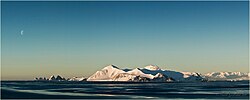Astrolabe Island
| Astrolabe Island | |
 Astrolabe Island from north-west | |
|---|---|
| Location | |
| Location: | 63°18’58"S, 58°40’59"W |
| Data | |
Astrolabe Island is an island three miles long, lying in the Bransfield Strait, 14 miles north-west of Cape Ducorps, a headland of the Trinity Peninsula in the British Antarctic Territory. At its summit it rises to 1,840 feet above sea level and it shows, in its small compass, a dramatic scenery.
The island was discovered by the French expedition, 1837-1840, under Captain Jules Dumont d'Urville, and named by him for his chief expedition ship, the Astrolabe. The island was recharted by Discovery Investigations in 1930-1931.
The island was photographed from the air and triangulated by Falkland Islands and Dependencies Aerial Survey Expedition of 1956–1957.
Geology
Astrolabe Island is predominantly volcanic rocks, with coarse grained mafic dolerite making up most of the landing site on the east end. The steep pyramid peaks, called the Dragons Teeth, may be the vents of an old volcanic complex, probably related to the Shetland subduction zone to the north.[1]
Peaks of the island include:
References
- ↑ Holliday, Joseph (Geology Professor, El Camino College)
- Gazetteer and Map of The British Antarctic Territory: Astrolabe Island